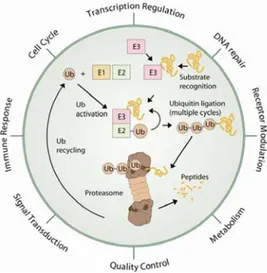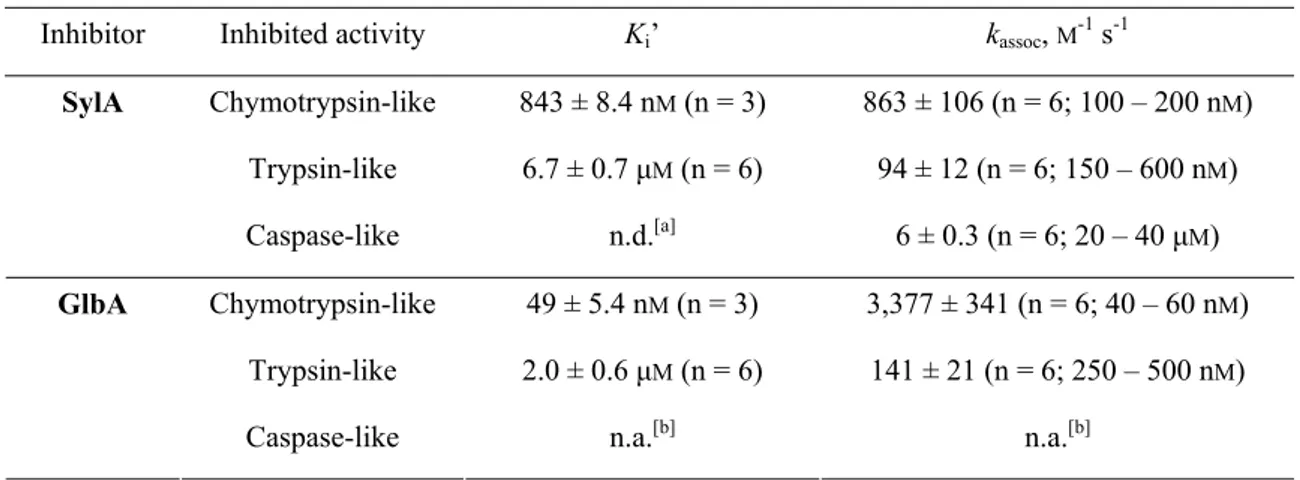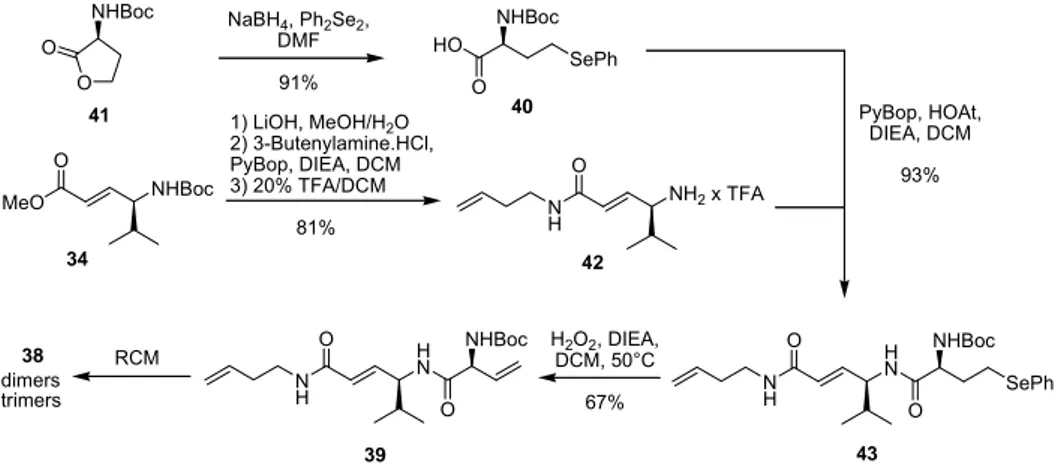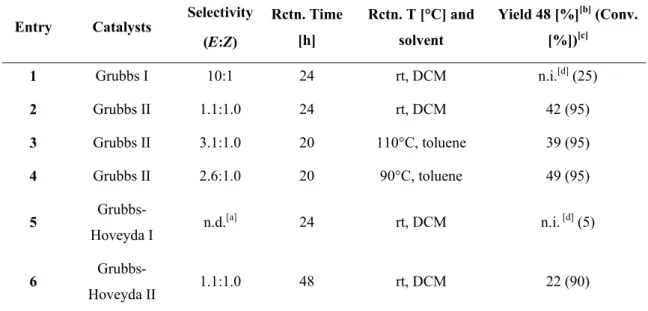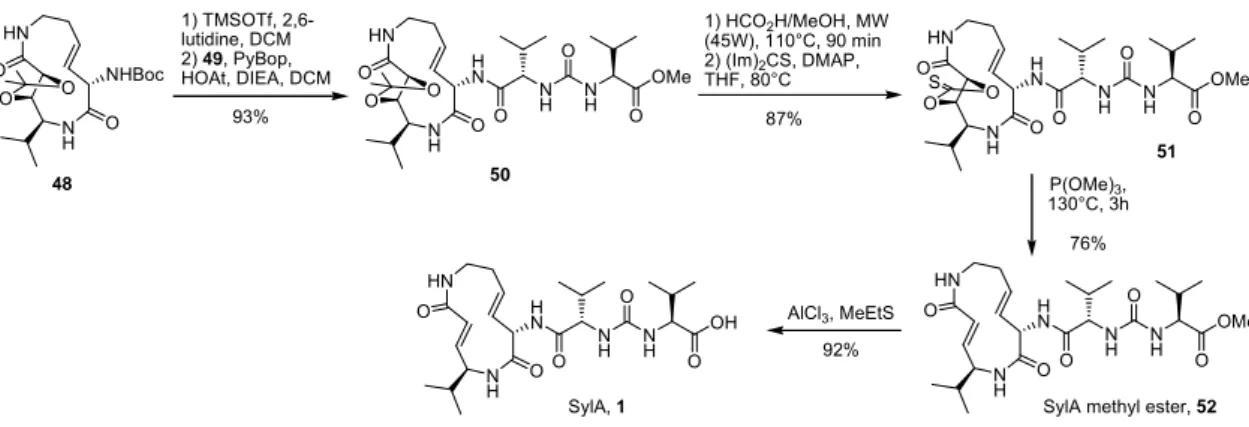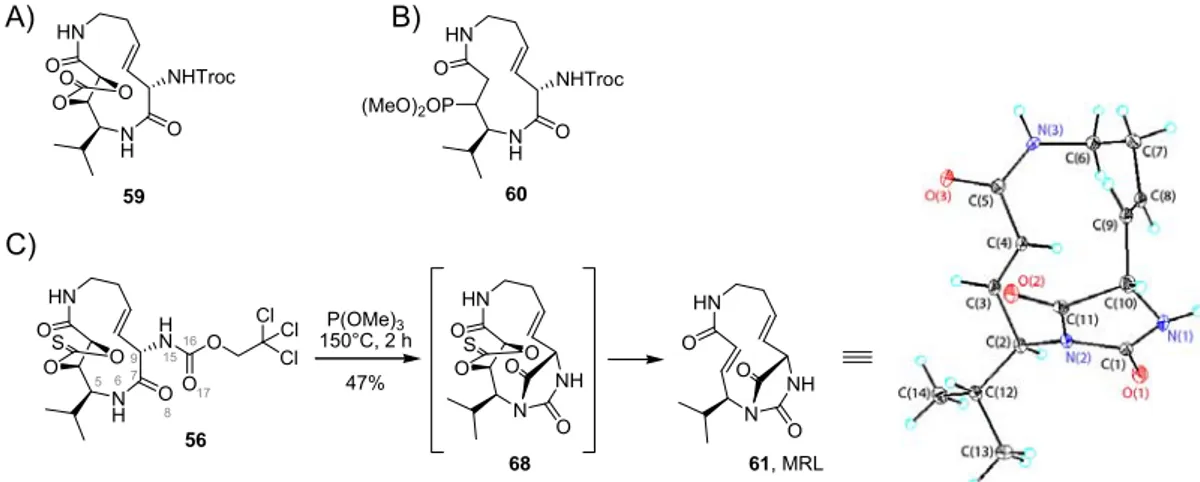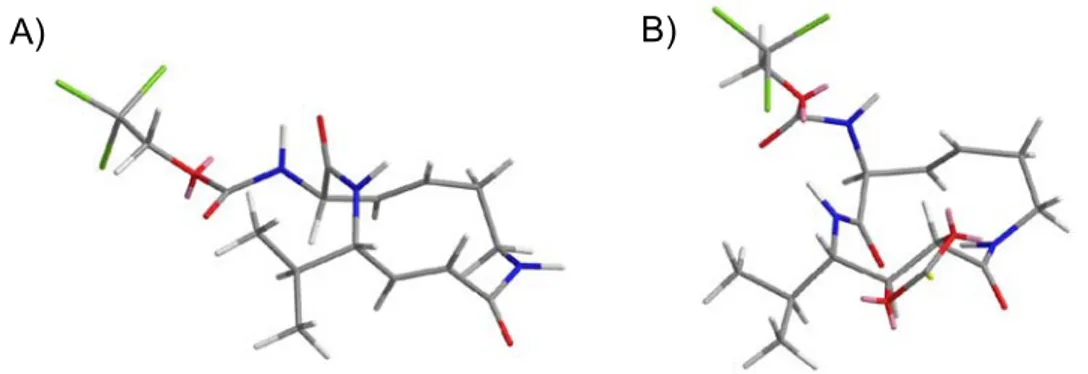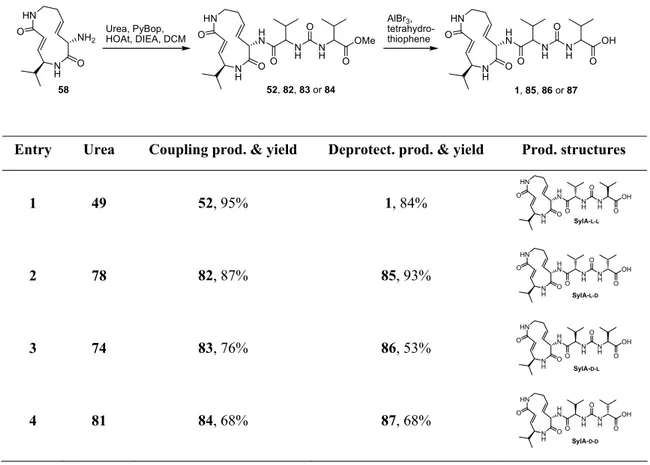Synthetic and Structure-Activity Studies of the 20S Proteasome Inhibitor Syringolin A
Dissertation
Von M.Sc.-Chemiker Jérôme Clerc
aus Rueil-Malmaison (Frankreich)
Synthetic and Structure-Activity Studies of the 20S Proteasome Inhibitor Syringolin A
Zur Erlangung des akademischen Grades eines Doktors der Naturwissenschaften
(Dr. rer. nat.)
von der Fakultät für Chemie der Universität Dortmund
angenomene
Dissertation
Von M.Sc.-Chemiker Jérôme Clerc
aus Rueil-Malmaison (Frankreich)
1. Gutachter: Prof. Dr. Herbert Waldmann 2. Gutachter: Prof. Dr. Mathias Christmann
Tag der mündlichen Prüfung: 16. April 2010
Die vorliegende Arbeit wurde in der Zeit von Oktober 2005 bis März 2010 am
Chemical Genomics Centre der Max-Planck-Gesellschaft in Dortmund unter der
Anleitung von Prof. Dr. Herbert Waldmann and Dr. Markus Kaiser durchgeführt.
À ma famille
et
Marlene
Table of contents
1. Introduction ... 1
2. Background... 3
2.1. Natural products as starting structures for small molecule development...3
2.2. The ubiquitin-proteasome system and its modulation by proteasome inhibitors ...4
2.3. The natural product syringolin A ... 7
2.4. Previous synthetic approaches to the synthesis of syrbactin-like macrocycles... 11
3. Aim of the project... 14
4. Results and discussion... 16
4.1. Studies towards the total synthesis of syringolins... 16
4.1.1. Synthesis of syringolin B (SylB)... 16
4.1.2. Synthesis of syringolin A (SylA) ... 19
4.1.2.1. Macrolactamization pathway ... 19
4.1.2.1.1. Synthesis of the β,γ-dehydrolysine building block... 20
4.1.2.1.2. Synthesis of the α,β-unsaturated building block...22
4.1.2.1.3. Macrolactamization studies ...22
4.1.2.2. Metathesis pathway...23
4.1.2.2.1. First approach to employ RCM in syringolin macrocycle synthesis ... 24
4.1.2.2.2. RCM: second approach ... 26
4.1.2.2.3. Establishment of a more convergent route to SylA and analogues...29
4.1.2.2.4. Convergent synthesis of SylA and SylA isomers ... 34
4.1.2.3. Synthesis of a saturated SylA derivative...38
4.2. Chemical biology studies with syringolins ... 40
4.2.1. Synthesis and use of a rhodamine-tagged syringolin A derivative Rh-SylA ... 40
4.2.1.1. Synthesis of Rh-SylA... 40
4.2.1.2. ABPP studies with Rh-SylA with mammalian cell lysates... 41
4.2.1.3. The use of Rh-SylA for plant pathogen interaction studies ... 45
4.2.2. Structure-activity relationships of syringolins ... 45
4.2.2.1. Structural determinants of potency and subsite selectivity deduced from structural and biochemical studies... 45
4.2.2.2. Synthesis of a lipophilic analogue... 48
4.2.2.3. Synthesis of pegylated analogues... 50
4.2.2.4. Synthesis of a SylA-GlbA hybrid ... 54
4.3. A bicyclic hydantoin as an activity-based probe: discovery of a new GAPC inhibitor . 56 5. Summary and conclusions ... 61
5.1. Summary and conclusions (English)... 61
5.2. Zusammenfassung und Ausblick (German) ... 68
5.3. Résumé et conclusions (French) ... 75
6. Experimental Part ... 82
6.1. Materials, instruments and general methods for purification and analyses... 82
6.2. Synthesis of syringolin B (SylB, 2)... 85
6.3. Synthesis of syringolin A (SylA, 1) ... 95
7. References and Notes ... 167
8. Abbreviations... 171
9. Curriculum Vitae ... 172
10. List of publications and patents... 174
10.1. Publications ... 174
10.2. Patents... 174
11. Acknowledgements ... 175
1. Introduction
In chemical biology, bioactive small molecules are applied to biological systems such as living cells for studying and manipulating biological processes.
1Such a small molecule-based approach for studying biology has several advantages over more classical research strategies such as genetic knock-out studies: The biological effect induced by small molecule modulation is usually rapid and can be spatially and temporally controlled. It is often reversible and conditional as small molecule application can be initiated at any developmental stage of the studied biological system. Moreover, the observed biological effect is tunable by varying the concentration of the small molecule probe. Finally, small molecule probes can be tagged with additional functionalities that allow to accumulate further information in biological experiments. For example, the proper attachment of fluorophores on a bioactive small molecule targeting a protein of interest generates a probe that can directly be employed in imaging applications. Besides these straightforward experimental advantages, small molecule interference has at least one additional conceptual advantage over genetic manipulations. While gene mutations act on the gene-level, small molecules modulate the function of the gene products. Consequently, small molecules interfere at a much more sophisticated and biologically relevant level;
accordingly, they are in contrast to genetic studies able to differentiate between different protein forms that result from the same gene, e.g. by alternative splicings or post-translational modifications.
Despite these huge advantages of small molecule manipulation of biological systems, the widespread use of chemical biology methods in biological research is limited by an inherent major disadvantage: In order to be feasible, such an approach requires the availability of suitable small molecules that induce a desired biological effect with high selectivity and potency. To date, only a limited number of proper small molecules for a restricted number of protein targets are though known.
To overcome this limitation, several concepts for identifying proper small molecules
have evolved in the last years. Among them, high-throughput screening of compound
collections to elucidate proper small molecule modulators is nowadays most regularly
used. As a consequence, approaches for synthesizing ‘intelligent’ compound
collections such as Biology-oriented synthesis (BIOS) or Diversity-oriented synthesis
(DOS) have been devised to reduce compound synthesis and screening efforts.
2In
addition, more rational, structure-based approaches such as ‘virtual screening’ or fragment-based drug discovery are often employed.
3An alternative and in the past widely used method for identifying proper small molecules is the use of biologically active natural products as starting points for chemical probe synthesis.
4In this work, such an approach has been followed with the aim to develop a small molecule for probing the plant immune system. To this end, a peptidic natural product named syringolin A was chosen as a target structure for small molecule development. Syringolin A was reported to induce a plant-protective effect vs. various plant pathogens upon application on plants. In contrast to most agrochemicals, this interesting effect however was not caused by an antimicrobial activity against the plant pathogens but by an apparent modulation of the plant immune system. The molecular target of syringolin A and a synthetic route to this natural product class though was unknown at the beginning of this work.
During the course of this PhD thesis, in which several chemical biology studies
with syringolin A and derivatives thereof were performed, several unexpected findings
either from the own research work or reported in literature, opened up possibilities for
promising ‘side projects’ that were originally not even anticipated. Accordingly, the
search for a suitable small molecule probe of the plant immune system ended up with
an access to a promising new class of potent anti-cancer agents. Even more particular,
the discovery of a new scaffold structure for covalently labelling glyceraldehyde-3-
phosphate dehydrogenase has been accomplished. This work therefore gives a striking
example on the unexpected but nevertheless promising results that can be achieved by
basic science research.
2. Background
2.1. Natural products as starting structures for small molecule development
Since the first description of chemotherapeutic treatments, Nature has always played a prominent role for the identification of therapeutic agents.
5In fact, in the beginning of commercial drug discovery, the vast majority of chemotherapeutics were derived from natural products. However, with the advance of high-throughput screenings (HTS) in the 1990’s, natural products stepped out of the focus of the pharmaceutical industry, resulting in a significant decrease of natural product-based drugs released on the market.
6The emergence and technological improvement of high-throughput screening (HTS) nowadays enables to test extremely large compound libraries and to evaluate their potency against various biological targets in a very small time frame. The build- up of these huge screening capacities however demanded the allocation of compound libraries of appropriate size. To overcome this bottleneck, combinatorial chemistry soared up to provide a facile and rapid access to drug-like screening libraries of simple compounds with a high diversity and in a low cost fashion.
7,8Nevertheless, despite the big investment of the pharmaceutical industry and the generation of millions of compounds, it turned out that the biological relevance of combinatorial libraries was rather low, delivering only unexpected low numbers of lead structures suitable for further drug development.
These disappointing results led to a renaissance of natural products in drug
discovery. This new awakened interest in natural products stem from their inherent
biological relevance. As natural products are synthesized by living organisms to
protect and defend themselves and are therefore the result of a long process of the
natural selection, their chemical structures are biologically prevalidated for protein
interactions. Moreover, their use is not restricted to their original biological function in
the producing organism but can exert a biological effect also in other organisms. For
example, large varieties of new scaffolds have been isolated from deep-sea organisms
such as sponges or marine bacteria and are currently used to treat human pathologies
and disorders.
9,10Consequently, natural products are nowadays again in the focus of
drug discovery efforts, either as ‘direct’ lead structures or as scaffolds for compound
library synthesis as in Biology-oriented synthesis (BIOS).
While chemical biology approaches in mammalian cell studies are today well established, the use of small molecules in plant biology research is still in its infancy.
11Only a limited number of compounds are used to date, although more-and-more small molecule studies have appeared in the last years. Of these probes, most are natural product-derived, exemplified by Brefeldin A that is used in plant vesicular transport studies or Concanamycin A or Bafilomycin A for elucidating the role of V-ATPases on plant cell tugor pressure.
2.2. The ubiquitin-proteasome system and its modulation by proteasome inhibitors
As described below, the syringolin natural products that are in the focus of this PhD work modulate the ubiquitin-proteasome system by inhibiting the eukaryotic 20S proteasome. For this reason, a short overview on the constitution and biological role of the ubiquitin-proteasome system is given.
Since its discovery in the late 1970’s, the ubiquitin-proteasome system (UPS) has been widely studied due to its direct involvement in almost all biological processes of living cells. It consists of several protein components that act in concert to achieve a regulated proteolysis of proteins. The significance of this degradation system is highlighted by the award of the Nobel Prize in Chemistry “for the discovery of ubiquitin-mediated protein degradation” to the UPS research pioneers Aaron Ciechanover, Avram Hershko and Irwin Rose in 2004.
One of the key player and name giving factors of the UPS is the protein
ubiquitin. It is a small protein of about 8.5 kDa, highly-conserved in all eukaryotic
species with a sequence similarity between the human and yeast variant of 96%. As
indicated by its name, ubiquitin is ubiquitously expressed in all eukaryotes. In
combination with the 26S proteasome and the ubiquitin-loading enzymes E1-E3,
ubiquitin forms the ubiquitin-proteasome system which main function is the
proteolysis of proteins which are destined for degradation and the cleavage of unfolded
or misfolded proteins (Figure 1).
12,13,14To this end, a cascade of enzymes known as
E1, E2s and E3s tag such proteins with at least four ubiquitin units, thereby directing
them to the proteasome which then acts as the proteolytic core system.
Figure 1. Ubiquitin-mediated proteolysis and its relevance in different biological functions15
The 26S proteasome is a 2000 kDa complex of various proteins that can be classified into the 20S core particle structure and two 19S regulatory caps (Figure 2).
The proteolysis occurs in the interior of the barrel-shaped 20S structure. The two 19S regulatory subunits overtake the recognition of the ubiquitin-tagged proteins, cleavage of the polyubiquitin chains, unfolding and translocation into the 20S proteasome. The 20S proteasome consists of four stacked ring systems that are arranged in a α
7β
7β
7α
7manner. The α-subunits, in combination with the 19S subunits, regulate the access to the proteolytic sites which are located at the inner side of three of the seven β-subunits.
The catalytic residue is a N-terminal threonine moiety which is situated at the β1-, β2-, β5-subunit.
A) B)
Figure 2. A) Schematic diagram of the 26S proteasome.16 B) Surface representation of the yeast 20S proteasome crystallized in the presence of bortezomib. The various proteolytic surfaces are marked by a specific color coding: blue = subunit β1; red = subunit β2; and yellow = subunit β5. The nucleophilic threonine (T1) and bortezomib are presented as a ball-and-stick model.17
The three different proteolytic sites of the 20S proteasome feature distinct substrate specificities. The β5-subunit shows a chymotrypsin-like activity which cleaves peptide bonds after hydrophobic residues (e.g. tyrosine, tryptophan, and phenylalanine); the β2-subunit exerts a trypsin-like site which cuts after basic residues (lysine and arginine) whereas the β1-subunit possesses a caspase-like activity resulting in preferential cleavage after acidic residues (aspartic acid, glutamic acid). Protein degradation by the proteasome normally results in peptide fragments with an average length of 7 to 9 amino acid residues which are either used for antigen presentation at MHC class I complexes or are further degraded by additional proteases to refill the amino acid pool for new protein synthesis.
Although the UPS has major implications in various cellular processes such as regulation of cell cycle, DNA repair, immune and inflammatory responses and cancer,
18,19,20,21,22,23,24inhibition of the UPS has surprisingly emerged as a valuable approach for the development of novel anticancer therapies. In fact, the peptide boronic acid PS-341 (bortezomib) has recently been approved by the U.S. Food and Drug Administration for the treatment of relapsed and/or refractory multiple myeloma and is commercially available under its trade name Velcade ®.
NH O
O O
Cl
OH
Salinosporamide A (NPI-0052) O
NH
O O
HN O NH H O N O
Carfilzomib (PR-171) NH
H O N O
N BOH
OH N
Bortezomib
NH H O N O
N BOH
OH OH CEP-18770 N
O
H
Figure 3. Chemical structure of the marketed proteasome inhibitor Bortezomib and of the proteasome inhibitors currently evaluated in clinical trials.
Although the efficiency of Bortezomib in monotherapy has been considered as
astonishing and exciting, side effects and resistances are frequently observed and
combinations of bortezomib with other therapeutics are now under evaluation.
25Consequently, three more proteasome inhibitors are currently evaluated in clinical
trials, i.e. carfilzomib, NPI-0052 (also known as salinosporamide A) and CEP-18770
(Figure 3).
26,27,28NH H O H O
N
H2N O O NH
H2N O O OH
Fellutamide B
O HN HN
NH O S
N HN O N O HN
O NH
O H
N O
HN OMe
Argyrin A NH
HO N
H O
OHN
NH2 NH
HO
HO
O
O NH
O
O O
TMC-95A
Figure 4. Recently discovered proteasome inhibitors from natural sources.
Despite these advanced clinical studies, alternative proteasome inhibitors are still urgently sought. Natural products have been an invaluable source for proteasome inhibitors, exemplified by the three natural products TMC-95A, fellutamide B or argyrin A (Figure 4) that have recently been disclosed.
29,30,312.3. The natural product syringolin A
The peptidic small molecule syringolin A (SylA, 1) (Figure 5) was isolated in 1998
from bacterial strains of Pseudomonas syringae pv. syringae (Pss). This plant
pathogen causes the brown spot disease on various plant species. In 1999, syringolins
B-F were subsequently reported as minor metabolites of Pss. SylA is biosynthesized
by a mixed non-ribosomal peptide synthetase (NRPS) / polyketide synthetase (PKS)
gene cluster exclusively under infection conditions. The syringolins (in particular
syringolin B and E) have related chemical structures to another class of natural
products known as glidobactins and cepafungins (Figure 5). The main structural
differences between syringolins and glidobactins are an additional (E)-configured
double bond in the syringolin A macrocycle and the presence of an exocyclic urea
moiety in the syringolins while glidobactins feature a dipeptide residue.
HN
NH HN
O
O N
H OH
O O
R5 HN
NH HN
O
NH N H
OH O
O
O HN
NH HN
O
NH N H
OH O
O
O
SylA, 1: R1= Me, R2= Me SylC: R1= Me, R2= Et SylD: R1= Et, R2= Me SylF: R1= Et, R2= Et
SylB, 2: R3= Me, R4= Me SylE: R3= Et, R4= Me
R6
GlbA, 3 or Cepafungin II: R5= -(CH2)6CH3, R6= H GlbB: R5= -(CH2)2CH=CH(CH2)4CH3, R6= H GlbC: R5= -(CH2)8CH3, R6= H
GlbD: R5= -(CH2)4CH(OH)CH2CH3, R6= H GlbE: R5= -CH2CH(OH)(CH2)4CH3, R6= H GlbF: R5= -(CH2)4CH3, R6= H
GlbG: R5= -(CH2)6CH3, R6= OH
Cepafungin I: R5= -(CH2)5CH(CH3)2, R6 = H Cepafungin III: R5= -(CH2)3CH(CH3)2, R6 = H
R2 R1 R4 R3 OH
O O
Figure 5. Chemical structures of the major metabolite syringolin A of the syringolin family and the additional minor metabolites produced by Pss. The chiral centers of the amino acid residues were not assigned in the original structure elucidation and were elucidated only by our syntheses. For clarity, they have been added to this figure. In addition, the chemical structures of the structurally-related glidobactins and cepafungins are represented.
In the original structure elucidation of the syringolins, the chiral centers at the amino acids could not be elucidated. Although the analysis of the biosynthesis gene cluster suggested an overall (
L)-configuration, definite prove of the stereochemistry was only achieved by chemical synthesis performed during this PhD project (see section 4.1.2.2.4 for details).
The interest to develop syringolin A into a small molecule probe for studying the plant immune system stemmed from a report in literature, in which the initiation of a plant immune response was described after application of syringolin A to non-host plants. Interestingly, while syringolin A application to healthy plants resulted in no evident phenotype, application of syringolin A to rice plants (Oryza sativa) infected with the blast fungus Pyricularia oryzae led to a plant protective and infection- counteractive plant immune reaction known as hypersensitive response. The same protective and curative properties of SylA were observed with wheat and powdery mildew as the plant infection.
32,33,34In plant biology, compounds with such an immune-response promoting activity are generally referred to as elicitors. Most elicitors however are of high molecular weight, being whole proteins or large carbohydrate structures. Only a limited number of small molecule elicitors are known to date, thereby highlighting again the interesting biological activity of SylA.
In 2006, an interesting paper from the Bachmann group at the Hawaiian Cancer
Center appeared; describing an anti-proliferative and apoptosis-inducing property of
SylA in certain cancer cell lines were described.
35However, no mode-of-action of
SylA was mentioned.
During the course of this PhD thesis, Groll et al. then finally reported SylA’s molecular target and biological function: SylA induces an irreversible inhibition of the eukaryotic 20S proteasome by a novel mechanism, thereby providing a previously unrecognized link of the plant immune response with the ubiquitin proteasome pathway. This inhibition facilitates infection of plants by a yet unknown mechanism, suggesting that SylA acts as a bacterial virulence factor.
36In addition, the authors disclosed that the structurally related natural product glidobactin A (GlbA, 3) also potently inhibited the 20S proteasome.
37,38,39,40Glidobactins have been isolated from Polyangium brachysporum and reported as antifungal compounds and antitumor antibiotics. In vitro testing of glidobactins (principally A, B and C) revealed a broad activity against clinically important pathogenic fungi such as Candida albicans, Cryptococcus neoformans or Aspergillus fumigatus, although their in vivo antifungal potency was considered as only marginal.
More interestingly, a strong cytotoxicity was detected against various tumor cell lines.
Subsequent studies with mice implanted with P388 leukemia revealed a dramatic prolongation of lifetime under glidobactin treatment.
41Biochemical inhibition assays were then used to evaluate the inhibition potency and subsite selectivity of SylA and GlbA (Table 1).
Table 1. Apparent Ki’ values and rates of covalent inhibition (kassociation) over inhibitor concentrations.
Inhibitor Inhibited activity Ki’ kassoc, M-1 s-1
Chymotrypsin-like 843 ± 8.4 nM (n = 3) 863 ± 106 (n = 6; 100 – 200 nM) Trypsin-like 6.7 ± 0.7 μM (n = 6) 94 ± 12 (n = 6; 150 – 600 nM) SylA
Caspase-like n.d.[a] 6 ± 0.3 (n = 6; 20 – 40 μM) Chymotrypsin-like 49 ± 5.4 nM (n = 3) 3,377 ± 341 (n = 6; 40 – 60 nM)
Trypsin-like 2.0 ± 0.6 μM (n = 6) 141 ± 21 (n = 6; 250 – 500 nM) GlbA
Caspase-like n.a.[b] n.a.[b]
[a] n.d.: not determined. [b] n.a.: not active.
It turned out that both inhibitors acted in a non-competitive manner, suggesting an irreversible inhibition. SylA inhibited all three proteolytic activities, but with different potencies. While the chymotrypsin-like activity with a K
i’ of 843 ± 8.4 n
Mwas most potently inhibited, the trypsin-like activity was inhibited with a K
i’ of 6.7 ±
0.7 µ
M, while no K
i’ value for caspase-like inhibition could be quantified despite its
apparent inhibition. In contrast, GlbA was much more potent in inhibiting the chymotrypsin-like activity with a K
i’ of 49 ± 5.4 n
Mand the trypsin-like activity with a K
i’ of 2.0 ± 0.6 µ
Mwhile however the caspase-like activity was not inhibited at all in the concentration range tested.
Subsequent structural studies of the binding mode of SylA and GlbA to the yeast 20S proteasome confirmed the suggested irreversible binding mode (Figure 6).
These studies revealed that the observed irreversible inhibition is indeed a result of a Michael-type addition of the threonine active site residue to the α,β-unsatured amide moiety of SylA and GlbA. Interestingly, these studies also validated the noticed subsite selectivity. While SylA binding was found in all three proteolytically active subsites, GlbA was only accommodated in the β2 and β5 subunits. Due to their similar binding mode, SylA and GlbA were grouped into a collective class of natural product, named syrbactins.
A) B)
Figure 6. Stereo representation of the chymotryptic-like active site in complex with: A) GlbA and B) SylA. Magenta, covalent linkage of inhibitors with active site Thr1; dotted lines indicate hydrogen bonds. Black, residues performing specific interactions with SylA and GlbA.
Accordingly, the findings of Groll et al. also gave a mechanistic explanation to the previously observed anti-proliferative properties of SylA in cancer cells. As described in section 2.2, proteasome inhibitors are potential anticancer agents.
Consequently, SylA and analogues thereof might represent promising new
chemotherapeutics for the treatment of certain cancer types.
2.4. Previous synthetic approaches to the synthesis of syrbactin-like macrocycles
It has long been recognized that macrocyclic natural products often demonstrate high biological activities in conjunction with favorable pharmacological properties, turning them into interesting compounds for drug discovery efforts.
42Their observed potent biological potencies seem to be to the consequences of different aspects. First, the entropic loss while forming the protein-ligand complex is dramatically reduced by using macrocyclic inhibitors, resulting in higher target affinity. Second, it has been shown that macrocyclic inhibitors are more selective than linear ligands due to a fixation of target-specific conformations. Third, the physicochemical properties of macrocycles such as cyclic peptide-like drugs have empirically been shown to be more appropriate for membrane passage than of related linear peptide-like candidates.
Fourth, in the case of peptides, the proteolytic and metabolic stability of cyclopeptides is usually dramatically enhanced in comparison to linear ones.
43,44Despite the unambiguous potential of this class of natural products, their development into drugs was underexploited by the pharmaceutical industry for several reasons. One reason is that the molecular mass of these biologically active macrocycles often exceeds 500 Da; thereby violating the commonly adopted Lipinski’s rule of 5 for evaluation of the druglikeness of small molecules. Additionally, macrocyclic compounds frequently display complex molecular architectures, thereby limiting their synthetic accessibility and discouraging a possible industrial development. With the advance of new synthetic methodologies for macrocyclization such as ring-closing metathesis,
45multi-component reactions,
46metal-templated chelation
47or ring- closing-contraction sequences,
48this chemistry-derived disadvantage however starts to vanish.
Accordingly, syringolins seem as attractive target molecules for drug
discovery. They feature a highly rigid 12-membered macrocycle with two (E)-
configured double bonds and two amide functionalities. Due to their limited flexibility,
high affinity binding to the active subunit of the proteasome can be assumed which
contributes to the observed potent inhibition. Additionally, syringolins possess a
moderate number of stereocenters that are derived from amino acids and have a
molecular mass close to 500 Da, suggesting favorable pharmacokinetic properties.
To date, only two chemical syntheses of syrbactins have been reported. While syringolins have not yet been prepared, two total syntheses of glidobactin A have been reported by Oka et al. in 1988 and the Schmidt group in 1992. In addition, different unfortunately unsuccessful approaches towards the synthesis of the glidobactin core structure were reported by the group of Hesse in 1991.
49,50,51In all these syntheses, the macrocyclization proved as the most difficult step.
The first total synthesis performed by Oka et al. was based on successive peptide couplings (Scheme 1). In their approach, erythro-γ-hydroxy-(
L)-lysine 5 was directly employed without any protective groups leading to poor yields of only 0.2% of Glidobactin for the overall synthesis after several purification rounds.
HO O
NH2 DCC, HOBt, Et3N, THF OH
39%
NHCOCH2Cl O
HO
O NH2 NH2
OH HO
HO O
NH OH
O HN
HO O
NH O
ClH2COCHN
NH O
+H3N DCC, HOBt,
DMF 2.3%
HN
NH HN
O
O N
H OH
O OH O
GlbA, 3 4
5
6
7
Scheme 1. First total synthesis of Glidobactin A by Oka et al. in 1988.
In the total synthesis of the Schmidt group, erythro-γ-hydroxy-(
L)-lysine was generated in an orthogonally protected form by starting from the chiral butanetriol 8 (Scheme 2). In order to obtain this intermediate, 13 synthetic steps were necessary. In contrast to the Oka strategy, the macrolactamization was however performed between the C-terminal end of the alanine derivative and the ε-amino group of the hydroxylysine analogue. This key step proceeded in a much better yield of 20%. The overall yield of the total synthesis of GlbA however was only 0.8% due to the required 19 steps.
HN O
O NHBoc NHFmoc
OMOM C6F5O
HN
NH
O NHBoc
O DBU, 4-pyrrolidinylpyridine, OMOM
dioxane, tBuOH, 95°C 20%
GlbA, 3 O
O HO Ph
8
9 10
Scheme 2. Second total synthesis of Glidobactin A by Schmidt et al. in 1992.
Synthetic studies to the synthesis of the glidobactin macrocycle were also reported by the group of Hesse (Scheme 3). In their work, a strategic reductive N-N bond cleavage of a bicyclic intermediate 13 was examined to install the desired 12- membered ring system. While model studies with simplified analogues led to promising results, the synthesis of GlbA macrocycle itself could not be accomplished.
11
GlbA, 3 N
N O
HO O HO
OH
NH2 NH
NH O
HO HO
O NH2 Cl
O
12 13
Scheme 3. Attempted synthesis of Glidobactin A macrocycle by Hesse in 1991.
In summary, an overall analysis of the so far achieved syntheses of Glidobactin
A indicate that although these ring systems are synthetically accessible, they are
obviously synthetically challenging as overall yields were always below 1%. In fact,
the macrocyclizations proved as a very difficult step and could be obtained in the best
case with only 20% yield, leaving plenty of space for an improvement of the synthesis
by the employment of alternative synthetic methodologies.
3. Aim of the project
Due to the interesting biological properties of syringolin A in activating a plant immune response, the original aim of this PhD thesis was to develop syringolin A into a small molecule probe suitable for plant biology research. To achieve this, several different milestones were planned. First, a total synthesis of syringolin A was envisaged to obtain sufficient compound amounts to verify the literature-described biological effect. In addition, the synthetic route should also enable the generation of syringolin A derivatives that would then be employed for target identification, for example by pull-down experiments, capitalizing on the potentially reactive α,β- unsaturated Michael system. After this, an optimization of the biological properties of syringolin A to enhance its use as a chemical probe was envisaged.
However, as in parallel to the synthetic studies towards the synthesis of syringolin A, the elucidation of its target by Groll et al. appeared, the focus of the present work was partly shifted from target identification and development of a suitable probe for plant biology to the exploitation of the underlying structure-activity relationships of syringolins, thereby providing a rational basis for designing biologically more active and thus potentially better probes. To this end, the determinants of inhibition potency and subsite selectivity of syrbactins should become investigated. In addition, the selectivity of proteasome targeting by syringolins is an interesting question that was going to be explored in this PhD work.
To set this into practice, the first task was to achieve the first total synthesis of syringolin A (SylA). As however it was assumed that the syringolin A macrocycle due to its high ring strain was difficult to obtain, first a synthesis of syringolin B (SylB) was investigated. The employed synthetic route should then serve as a model system for the synthesis of syringolin A.
HN
NH
O H
N O O
NH N H O
OH O SylB, 2
HN
NH
O H
N O O
NH N H O
OH O SylA, 1
Figure 7. Chemical structures of the target molecules syringolin A and B. The configuration of the stereocenters was not known at the beginning of this PhD work.
Second, these chemical syntheses should be established in such a manner, that an unambiguous assignment of the chiral centers of syringolin A and B would become possible. To this end, several stereoisomers of SylA were identified as synthesis targets.
Third, an optimization of the inhibitory and pharmacokinetic properties of syringolins by derivatization was planned. Evaluation of these derivatives was envisaged by biochemical inhibition assays. Finally, the obtained inhibition data should allow the elucidation of the underlying structure-activity relationships of syringolins for proteasome inhibition and subsite selectivity.
Finally, the synthesis of a fluorescent probe of SylA was planned to obtain a potential probe for activity-based protein profiling (ABPP) of the proteasome, e.g. in plant-pathogen interactions. Moreover, this probe should have been employed to evaluate the selectivity of proteasome targeting by syringolins, thereby giving more insights into the potential of syringolins as anticancer agents.
Together, these studies should allow an in-depth investigation of the chemical
biology and potential of syringolins as probes for plant biology research. Due to the
potent anticancer effect of proteasome inhibitors, the findings of this PhD thesis
however are not only relevant for organic chemistry and potentially plant biology, but
might also have an impact on drug discovery.
4. Results and discussion
4.1. Studies towards the total synthesis of syringolins
Syringolin A (SylA) and syringolin B (SylB) are two metabolites extracted from Pseudomonas syringae pv. syringae (Pss) which feature many structural similarities.
SylB differs from SylA only by the substitution of SylA’s β,γ-dehydrolysine residue by a lysine moiety. For both natural products, the chirality of the stereocenters has not yet been assigned. However, an analysis of the gene cluster of SylA which does not contain any racemase domains suggest an all (
L)-configuration of the chiral centers. To confirm this assumption, the total synthesis of syringolin A was required. As the synthesis of SylA however appeared challenging due to the ring strain of the core macrocycle, the study of its total synthesis started with the synthesis of a less strained model compound. Correspondingly, a prior total synthesis of SylB was considered as a good opportunity to establish a feasible methodology for macrocyclization that might prove useful also for the synthesis of syringolin A.
4.1.1. Synthesis of syringolin B (SylB)
As macrolactamization obviously represents the most challenging step in the synthesis of SylB, it was envisaged to perform it at a late stage of the synthesis (Scheme 4).
HN
NH
O H
N O O
NH N H O
OH O SylB
O NH N
H O
OR O HO
O
NH2 H2N OR O R1O
NH2
NH
O H
N O OH
OH O
NHPG1 PGHN
H2N OR2
O
HN O
unsymmetric urea formation macrolactamization
peptide coupling Wittig reaction
Ph3PCHCO2R2
NH N H
OR O
O O
NHPG
NH
O NH2
O OR2
PG2
peptide coupling
Scheme 4. Retrosynthetic pathway to SylB using a macrolactamization as a key step.
This disconnection then leads to a cyclization precursor that is easily accessible by straight-forward peptide synthesis, requiring only a careful protecting group strategy to allow regioselective cyclization. Further disconnections then results in building blocks which can be obtained by classical amino acid modifications.
Noteworthy, this strategy does not involve the creation of chiral stereocenters; instead, the stereocenters are derived from the natural amino acids. Such an approach seemed as very practical for achieving the required determination of the configuration of the stereocenters of the natural SylB isomer, as all required amino acid starting materials were commercially available. In our first synthetic approach and in accordance with the reported biosynthesis,
52all stereocenters were assumed as (
L)-configured.
To put this retrosynthetic analysis into practice, the synthesis of SylB started with the preparation of the urea building block 18 (Scheme 5).
14 15
16
BocHN O
O
25 % TFA/DCM
>98% TFA x H2N OFm O
O
NH2 x HCl tBuO
O NH
tBuO N
H O
OFm O
HO O
NH N H O
OFm O 1) triphosgene,
DIEA, DCM 2) 15, DIEA, DCM 61%
wet HCO2H
>98%
Fm=
17 18
Scheme 5. Synthesis of the N,N’-unsymmetric urea 18.
To this end, a fluorenylmethylester 15 of valine was prepared by Boc- deprotection of the valine derivative 14 that was synthesized according to the protocol of Bayer.
53The N,N’-unsymmetrical urea side chain was then obtained following the procedure developed by Randad
54. Thus, (
L)-H-Val-OtBu 16 and triphosgene were used to form in situ an isocyanate intermediate which was then further treated with the ammonium salt 15 to afford the urea 17. Finally, deprotection of the tert-butyl ester group by acid treatment of 17 led to the desired urea building block 18.
With the urea in hands, the synthesis was continued with the generation of the cyclization precursor (Scheme 6). Accordingly, (
L)-Boc-valine methyl ester 19 was reduced to the corresponding aldehyde by DIBAL-H reduction, followed by a Wittig reaction to obtain the (E)-configured α,β-unsaturated derivative 20 in good yield.
Selective cleavage of the Boc-protecting group and subsequent peptide coupling of a
suitable protected lysine building block then yielded the dipeptide 21.
22 NHBoc
O NHBoc
O
MeO tBuO
1) DIBAL-H, toluene, -78°C 2) Ph3PCHCO2tBu, DCM
84%
1) HCl, dioxane/tBuOAc, -5°C to 10°C, 84%
2) Boc-Lys(Troc)-OH, PyBop, HOAt, DIEA, DCM, 85%
1) HCl, dioxane/tBuOAc, -5°C to 10°C, 83%
2) 18, PyBop, HOAt, DIEA, DCM, 75%
HN
NH
O H
N O
NH N H
OH O
O
O
HN O tBuO
O NHBoc NHTroc
HN O tBuO
O NH NHTroc
O H
N H
N O H OFm
N O HO
O NH NH2 x HCl
O H
N H
N O
OFm
1) Zn, THF/AcOH, 97%
2) (i) Wet HCO2H (ii) aq. HCl, >98%
1) PyBop, HOAt, DIEA, DMF, 30%
2) Piperidine/DMF, 73%
21
SylB, 2 23
19 20
Scheme 6. Total synthesis of SylB by macrolactamization.
At this stage, the Boc-protecting group was cleaved with HCl in a mixture of dioxane and tert-BuOAc and coupled with the urea building block 18. Selective deprotection of 22 by Troc cleavage with zinc in a mixture of THF and acetic acid, followed by acidic cleavage of the tert-butyl ester moiety led to the macrolactamization precursor 23.
The subsequent key ring closure of 23 was achieved under high-dilution
conditions with PyBop/HOAt as activating agents in DMF and produced the desired
product in a satisfying yield of 30%. Final removal of the remaining fluorenylmethyl
ester protecting group with piperidine in DMF afforded after reverse phase prep-HPLC
purification SylB (2) in an overall yield of 7.8% in 9 steps. Satisfyingly, the NMR
spectra of synthetic SylB and of a mixture of natural SylB isolated and synthetic SylB
were almost completely identical. In addition, a coinjection experiment on a chiral
HPLC system of synthetic SylB with natural SylB revealed no significant differences,
thus verifying our initial stereochemical assignment of SylB.
4.1.2. Synthesis of syringolin A (SylA)
4.1.2.1. Macrolactamization pathway
After the success of the total synthesis of syringolin B as a model system for the elaboration of a syringolin collection, the application of the same strategy for the synthesis of syringolin A was undertaken. Consequently, a similar retrosynthetical pathway using however β,γ-dehydrolysine instead of the lysine residue was followed (Scheme 7). For establishing a synthesis route amenable for derivatization, an attachment of the exocyclic urea side chain was planned at a later stage of the synthesis. Thus, a synthesis of the macrocycle by macrolactamization followed by attachment of the exocyclic side chain was envisaged.
unsymmetric urea formation HN
NH
O H
N O O
NH N H O
OH O SylA
HN
NH
O NHPG
O O
NH N H O
OR O peptide
coupling
HO
O
NH2 H2N OR O R1O
NH2
NH
O NHPG
O OH OH
O
NHPG HN
H2N OR2
O H2N O
macrolactamization
peptide coupling Wittig reaction
Ph3PCHCO2R2 PG1
Scheme 7. Retrosynthetic pathway to SylA using a macrolactamization as a key step.
To date, a synthesis of β,γ-dehydrolysine has not yet been reported. Main difficulties of its synthesis are the required protecting group manipulations without isomerization of the deconjugated double bond into the chemically more stable conjugated form. Consequently, the use of strongly deprotonating agents such as bases might cause an unwanted shift of the double bond from the β,γ- to the α,β-position.
Thus, to prevent the loss of the chiral information, it seemed advisable to use
protecting groups which could be preferably cleaved with acidic conditions.
4.1.2.1.1. Synthesis of the β,γ-dehydrolysine building block
Several approaches for synthesis of the β,γ-dehydrolysine building block were attempted. First, Beaulieu’s approach consisting of a Wittig reaction with a Garner aldehyde for the synthesis of β,γ-dehydro amino acids was followed. However, all our attempts to use this approach for the synthesis of β,γ-dehydrolysine failed. As a consequence, an alternative strategy was developed. For simplicity, again a synthetic approach in which the required (
L)-configuration was ‘pre-introduced’ by relying on a chiral pool approach was chosen. Accordingly, a Garner aldehyde appeared as a promising starting point for generation of the required amino acid. Several strategies for the conversion of this aldehyde into the β,γ-dehydrolysine such as Julia olefination or Stille coupling
55based approaches could be imagined to achieve the desired target structure. A Johnson-Claisen rearrangement-based methodology however would have the advantage to stereospecifically form the desired (E)-configuration and therefore was followed in this PhD thesis.
To this end, the vinylation of the (
D)-Garner aldehyde 24 with vinyl magnesium bromide was performed with good yields on multigram scales to afford the vinyl alcohol 25 as a mixture of diastereomers.
56Both isomers were then treated with triethyl orthoacetate under acidic catalysis and refluxed to yield a single product 27 with the desired double bond in the (E)-configuration (Scheme 8).
5724 NBoc O
O
NBoc O
OH
NBoc O
O OEt
NBoc
O OEt
BrMg O
THF
CH3C(OEt)3, EtCO2H (cat.), xylenes, 155°C 68% (2 steps)
25 26 27
Scheme 8. Vinylation of Garner aldehyde and Johnson-Claisen rearrangement towards the synthesis of β,γ-dehydrolysine.
Mechanistically, the Johnson-Claisen rearrangement is a [3,3]-sigmatropic rearrangement involving a six-membered transition state with a delocalized electronic structure. Under the employed reaction conditions, the chair conformation is preferred, which can be adopted by two transition states 28 and 29 in regard to the mixture of isomers used. As shown in Scheme 9, the oxazolidine substituent due to its bulkiness can be assumed to preferentially adopt an equatorial position for both enantiomers.
This arrangement results in trans-orientation of the vinylic proton and the chiral proton
of the oxazolidine, leading to formation of the (E)-configured olefin.
5826 27 NBoc
O O
OEt
NBoc
O OEt
O
O NBoc O
EtO
O NBoc O
EtO H
H H
H reflux
and
O BocN
O OEt
H H
S R
28 29
Scheme 9. Potential transition states involved during Johnson-Claisen rearrangement.
After establishment of the double bond, the terminal ethyl ester functionality was subsequently saponified to further react with diphenyl phosphoryl azide to undergo a modified Curtius rearrangement (Scheme 10).
59After the rearrangement, the reaction was quenched with an excess of trichloroethanol enabling the formation of the desired intermediate 31 in high yields and in an orthogonally protected form.
27 NBoc
O OEt
O
LiOH, MeOH, H2O
>98% NBoc
O OH
O
NBoc
O NHTroc
1) DPPA, Et3N, Tol 2) Trichloroethanol 93%
1) DMP, DCM, 0°C 2) NaClO2, NaH2PO4, 2-methyl-2-butene, tBuOH 69%
NHTroc HO
NHBoc
NHTroc HO
NHBoc O
PPTS, MeOH >98%
30
31
32 33
Scheme 10. Final steps towards the synthesis of the orthogonally protected β,γ-dehydrolysine building block 33.
To complete the synthesis of 33, first Jones oxidation of 31 with chromic acid in acetone was tested as it should enable the cleavage of the oxazolidine and the oxidation of the resulting primary alcohol to the desired carboxylic acid in one pot.
Unfortunately, only poor yields of the desired β,γ-dehydrolysine were isolated by this
method and led to the hypothesis that the intermediate aldehyde may be too sensitive
for the rather harsh reaction conditions of a Jones oxidation. The reaction conditions
were therefore changed: At first, the cleavage of the oxazolidine was realized by using
a catalytic amount of p-toluene sulfonic acid in methanol under reflux. Then, the
oxidation of the alcohol 32 was performed in two steps. First, the Dess-Martin
periodinane was used to provide the unstable aldehyde which was immediately further
oxidized to the corresponding carboxylic acid 33 using the Pinnick oxidation procedure.
604.1.2.1.2. Synthesis of the α,β-unsaturated building block
The synthesis of the α,β-unsaturated building block as a methyl ester followed the same procedure as described in section 4.1.1 but employed (methoxycarbonylmethylene)-triphenylphosphorane as the ylide component in the Wittig reaction (Scheme 11).
19 34
1) DIBAL-H, Tol 2) Ph3P=CHCO2Me 60%
BocHN O
OMe BocHN
O
OMe TFA x H2N
O 25% TFA/DCM OMe
>98%
35
Scheme 11. Synthesis of the α,β-unsaturated building block 35.
The resulting α,β-unsaturated derivative 34 was then further Boc-deprotected with a mixture of trifluoroacetic acid in dichloromethane to afford the desired coupling partner 35.
4.1.2.1.3. Macrolactamization studies
Finally, the two building blocks 33 and 35 were coupled, using general peptide coupling conditions to provide the intermediate 36.
38
36 37
HN
NH
O NHBoc
H O N O MeO
O NHBoc NHTroc PyBop, HOAt,
DIEA, DCM 65%
1) Zn, NH4OAc buffer pH 5.0, THF 2)LiOH, MeOH/H2O 3) aq. HCl
82% H
N O HO
O NHBoc NH2 x HCl
HATU, HOAt, DIEA, DCM/DMF
mass detected no product isolated 33 + 35
Scheme 12. Attempted synthesis of macrocycle 38 using a macrolactamization approach.
The selective deprotection of the Troc-group with zinc powder in buffer pH 5.0
followed by the saponification of the methyl ester cleanly provided the precursor for
the macrolactamization in good yields.
61Several strategies to perform
macrolactamization have been reported in the literature. Among them, HATU/HOAt-
mediated cyclization is nowadays one of the gold-standards, because it usually
proceeds with low levels of racemization and can induce even cyclization of ring- strained macrocycles.
O O
N N N N
O N N PF6
N N N N
O Me2N NMe2
O O
N N N N
O
O Me2N O Me2N
N N N N
O O HNH N N
N N
OH HN O
HOAt
H2N NH2
H2N
Scheme 13. Mechanism involved in the HATU-assisted macrolactamization.
